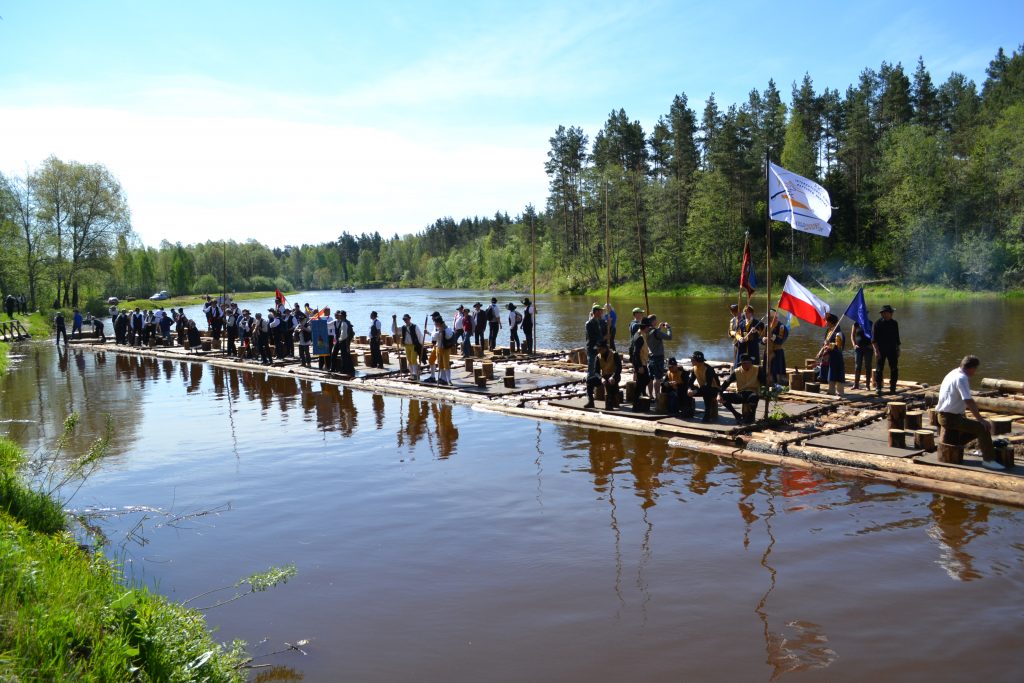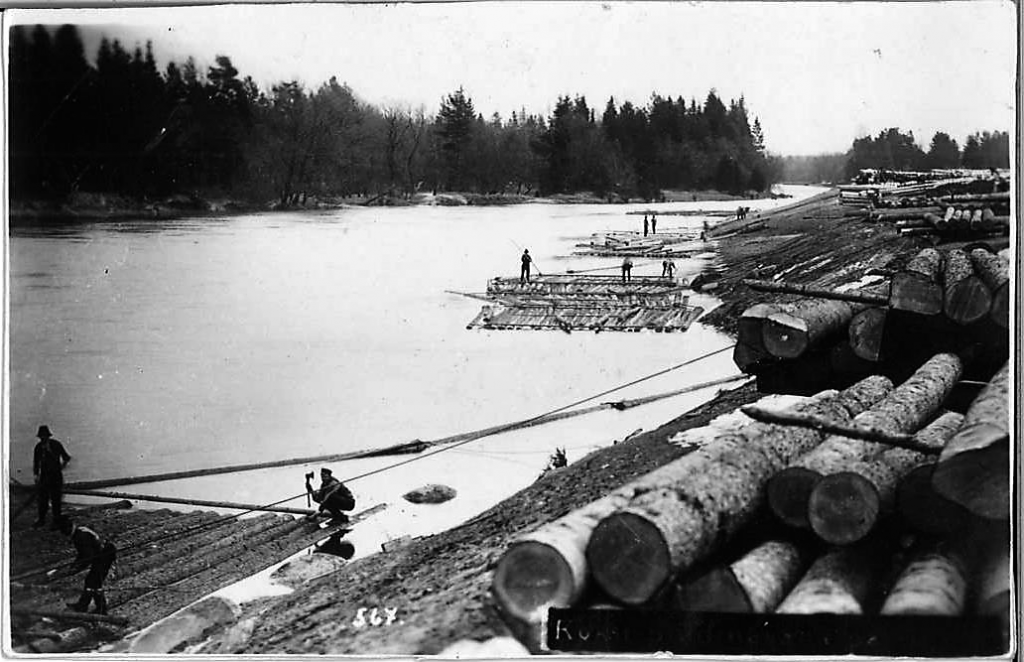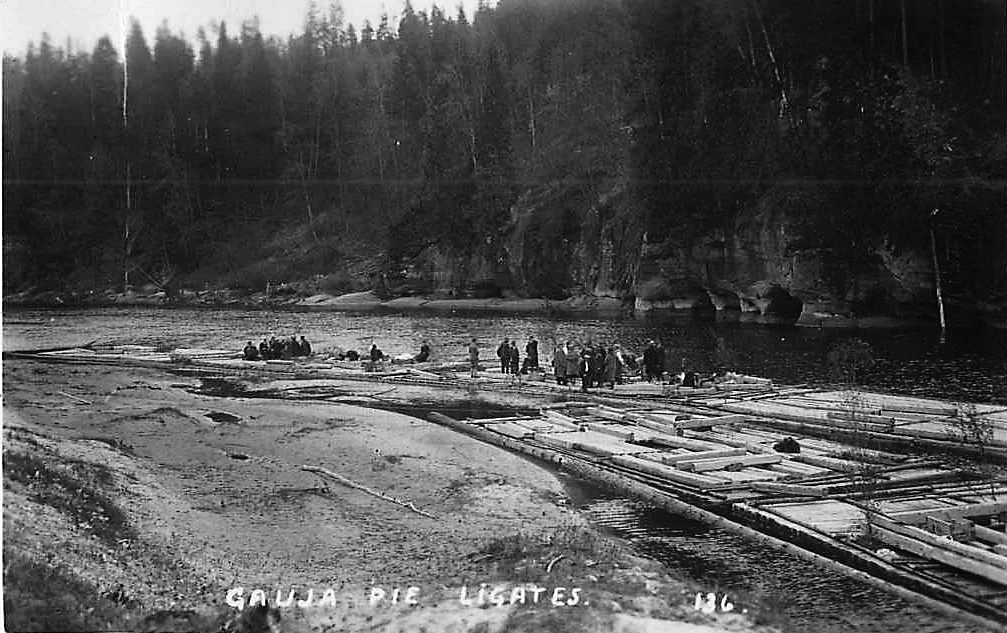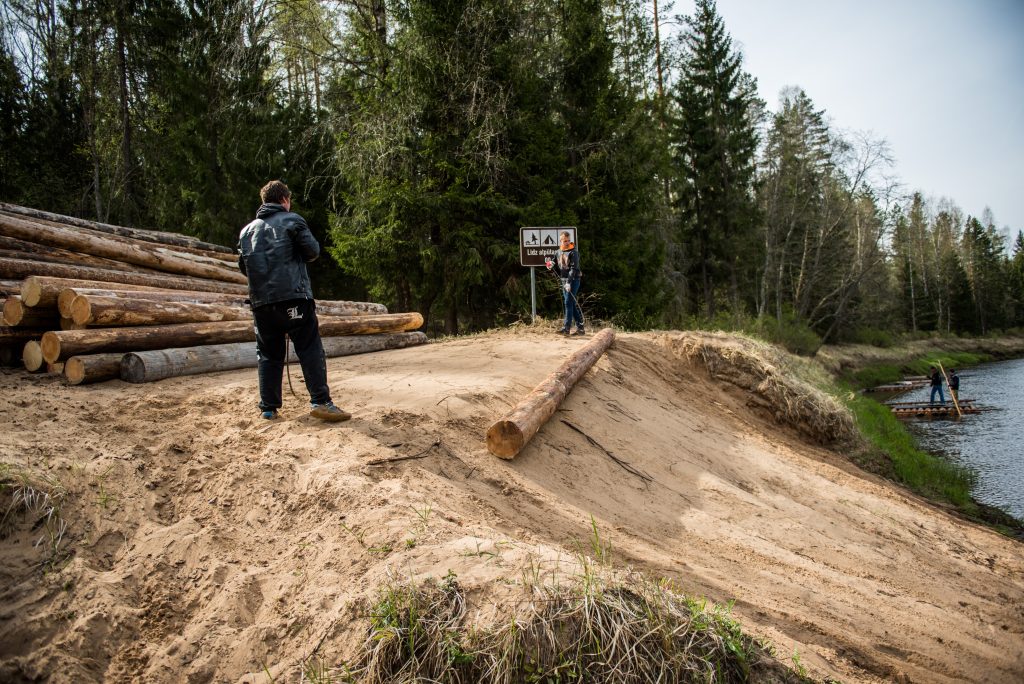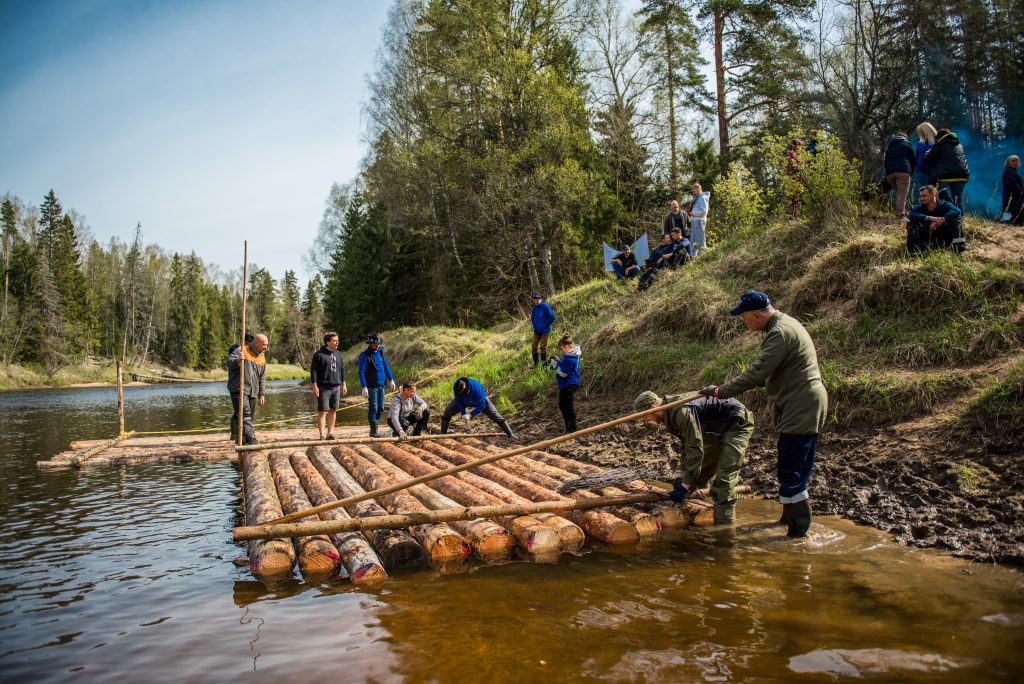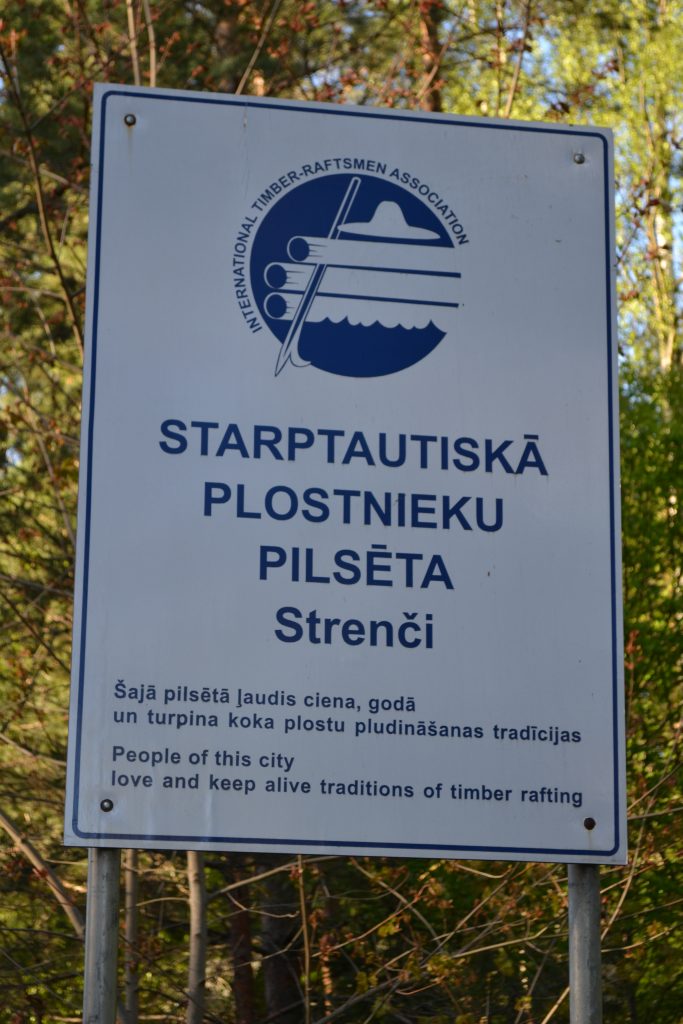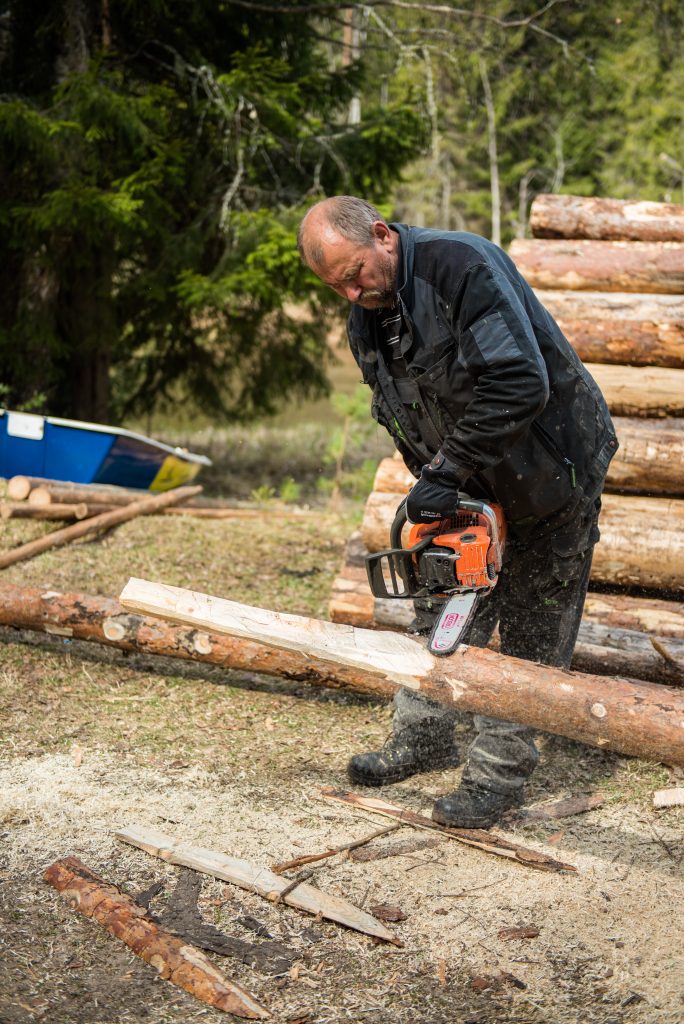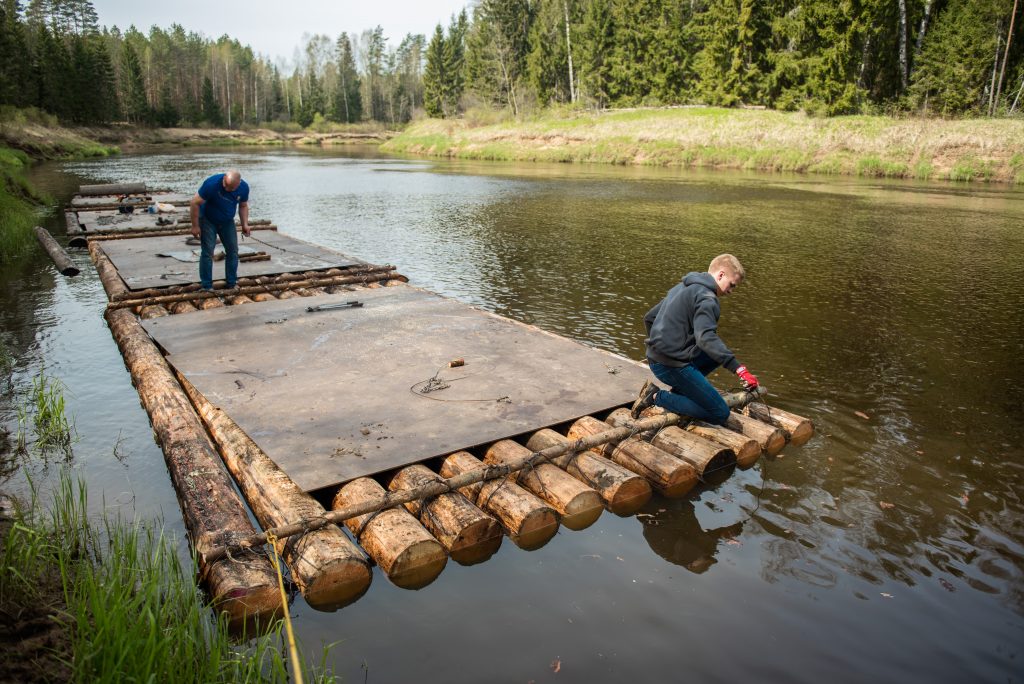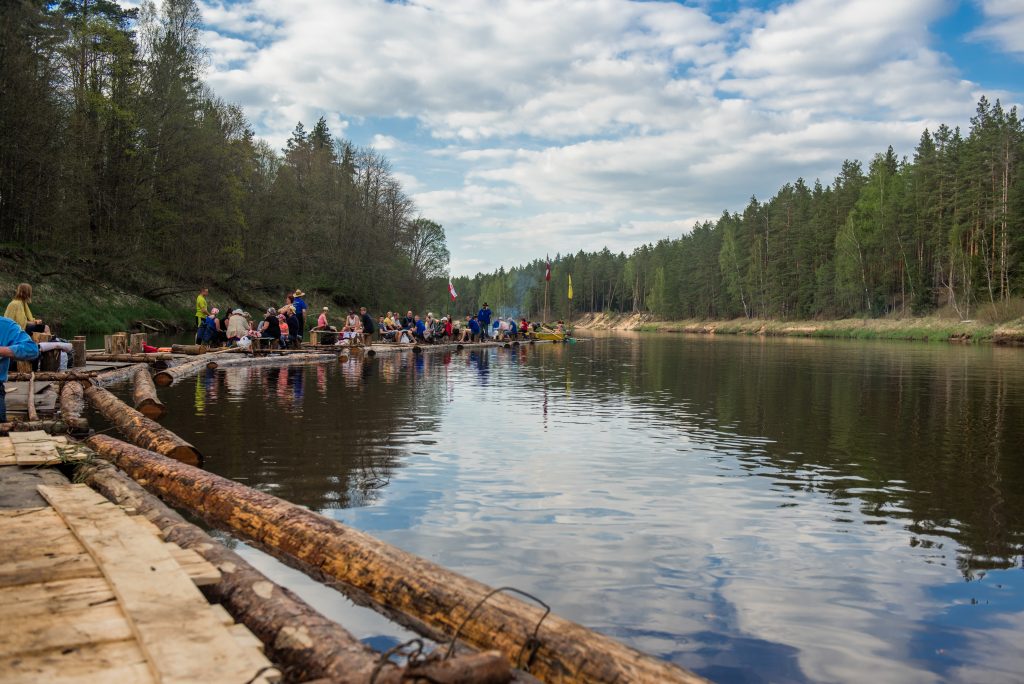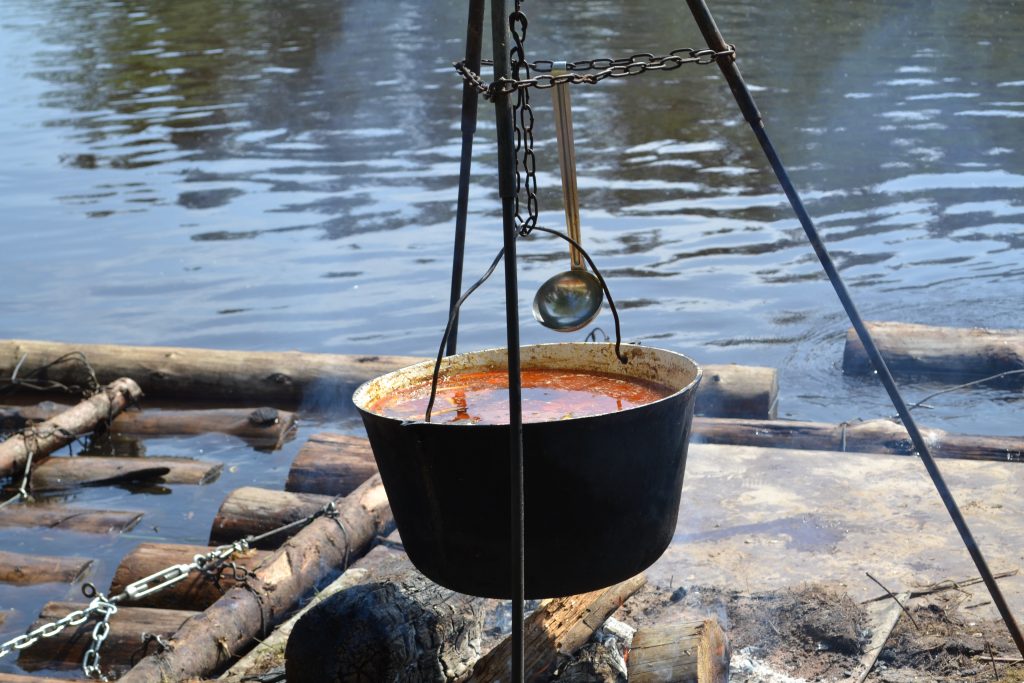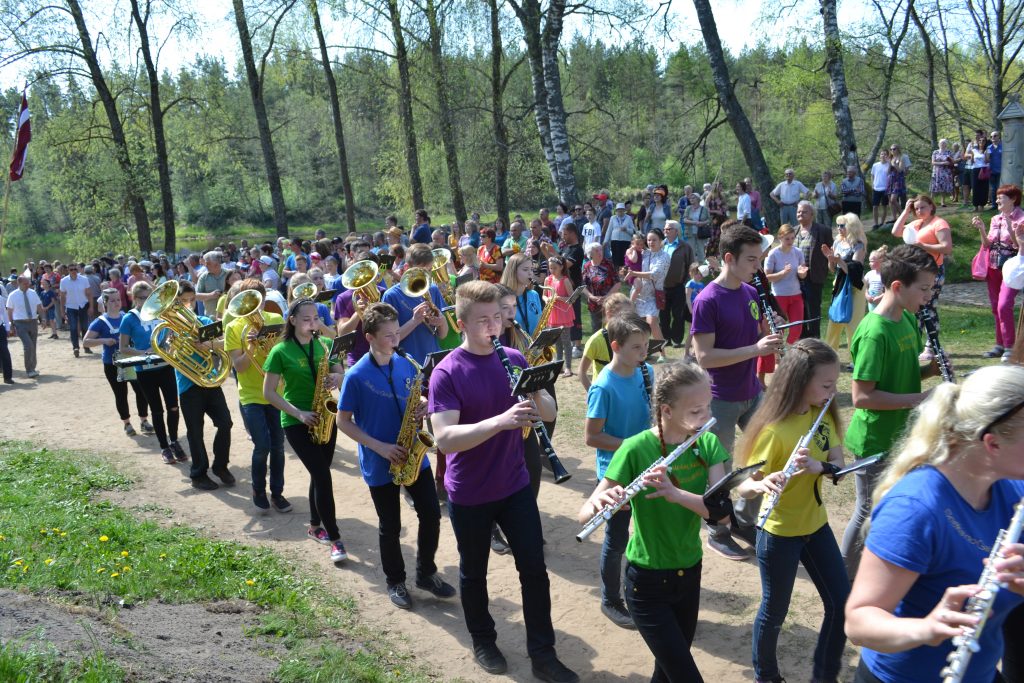Author:
Ieva Vītola
Oral traditions and their expressions, including language as a vehicle of intangible cultural heritage
Social practices, rituals and festive events
Traditional craft skills
Knowledge and practices concerning nature and the universe
Title
Traditional Timber Rafting Skills on the Gauja River (2018)
Floats.
Floaters (pludiņi): nickname for timber raftsmen, common in Alderi, a timber rafting village on the shores of Mazais Baltezers Lake.
Geography
Vidzeme region; Strenči and other areas along the banks of the Gauja, Latvia's longest river (Sinole, Lejasciems, Vidaga, Gaujiena, Vijciems, Valmiera, Cēsis, Sigulda, Murjāņi and other localities); Alderi, a timber rafting village on the shores of Mazais Baltezers Lake (Ādaži municipality)
Several communities in Vidzeme identify strongly with Gauja rafting tradecraft and its associated traditions. These include:
1. Earlier Gauja raftsmen and their descendents;
2. Members of the Society of Gauja Raftsmen, heirs to the Gauja rafting traditions, as well as current practitioners and promoters of the craft;
3. Residents of the town of Strenči and the surrounding municipality (at least 1,000 persons) whose local identity, both historically and today, is closely tied to timber rafting, Gauja raftsmen and their tradecraft;
The town's development has since the eighteenth century been closely tied to the forestry industry and included floating logs down the river.
It is not for nothing that Strenči is considered the capital of Gauja raftsmen and has since 2001 been one of Europe's international rafting towns.
*On January 1, 2018, 3,396 individuals had declared residency in Strenči (including 1,162 in the town of Strenči itself).
Significance in community life
The timber rafting skills of the Gauja raftsmen were seasonal and required knowing how to tie logs together into rafts and float them down the Gauja, making use of the river flow and understanding the nature of its currents in springtime.
Now that the Gauja is no longer utilized as a watercourse for timber drifting, the craft of the Gauja raftsmen is preserved and revived once a year. Every spring in the third week of May, one raft is assembled on the banks of the Gauja above the Spicu Bridge (between the towns of Valmiera and Smiltene) and drifted down the river to Strenči.
Activities
Every year several dozen men gather to make a raft, putting into use the skills they learned from old-time Gauja raftsmen. Working together, they take all day to lash six-metre long pine logs into a raft consisting of ten sections or cribs.
There are several stages to making a raft:
• Tying up the sections: using pike poles, logs are launched into the river, a boom is assembled on the river bank, logs are wired to crossbeams, and particular attention is paid to assembling the bow and the rear;
• Tying up the raft: the completed sections are connected to each other forming the raft;
• Outfitting the raft: eight-metre long oars are cut out using a saw, mounts are prepared for the oars, buffering logs are attached to the sides of each section, a setting pole is made of freshly peeled spruce, a cook-fire or camboose is set up on the raft, at least 15 poles or quants are prepared for propelling the raft.
The 37.5-kilometre journey from the Spicu Bridge to Strenči takes place over the next two days. The raftsmen, mainly men from Strenči and members of the Gauja Raftsmen's Society, take turns piloting the 80-to 90-metre long raft along the river current around sharp bends, sandbars, island, rocks, and over tree stumps.
Over the course of the journey, the river banks echo with the songs of the Gauja raftsmen.
The familiar raftsmen's adage that “a raft must go the way of the raft” can be heard frequently, along with the vernacular of timber rafting (plosta arkls (setting pole), galviņa (the bow of the raft), kumbrs (oar mount or bench), ķeksis (pike pole), zaplava (buffering log), ragata (log boom structure), malacis (a trainee/ apprentice rafter), noart plostu (to stop a raft by thrusting a wooden pole into the riverbank, usually several times before the raft comes to a complete stop)).
Each time they pass familiar locations that have been known for generations, these are named and remembered: Lielais Valgums, Mazais Valgums, Oliņas, Maskavieši, Pulkas, Staklītes, Dāvīša koki, Vācu sala, and Mīlestības vēris among others.
The rafting journey ends by the Old Oak in Strenči with the Gauja Raftsmen's Festival that gathers old-time Gauja raftsmen from all over Vidzeme, most of the people of Strenči and the surrounding county, as well as guests. The festival honours this deeply historical and culturally significant Vidzeme tradition with a celebratory meeting of the raft, the raftsmen's parade, and greeting.
Passing on and transferring skills
Even though the Gauja tradition of timber rafting has lost its original function, the activities noted here (tying rafts, piloting rafts, the Gauja Raftsmen's Festival) have a significant role both in safeguarding intangible cultural heritage and functioning as a symbolic, ceremonial event that affirms the identity of Strenči as a place that is a source of pride and belonging for local residents, the Gauja rafting tradition and timber rafting tradecraft for more than twenty years.
History
The skills of the Gauja raftsmen are as old as the Gauja waterway itself. It is known that in the nineteenth century, rafting was a common source of supplementary income for Vidzeme farmers in the springtime when logs were assembled into rafts and drifted down from the headwaters of the Gauja (Sinole, Lejasciems) to Carnikava.
Gauja rafts were 8.5 metres wide (limited by the distance between bridge piers) and up to 95 metres long. Gauja raftsmen needed to be experienced and skilled in order to successfully guide rafts around many islands, sandbanks, cliffs, sharp bends, over rapids and rocky banks without damaging the logs. Although rafting was lucrative, raftsmen earned their money through hard labour and often spent it in taverns on the way home.
An important turning point for this traditional Vidzeme craft was the construction of the Baltezers Canal in 1903, which was a three-kilometre long canal that connected the Gauja River with the Mazais Baltezers Lake. The rafted timber was driven through the canal into booms on the lake, where the logs were sorted and later transported through the Lielais Baltezers, Ķīšezers, or Jugla Lakes to Rīga.
In the twentieth century, timber rafting was gradually overtaken by log driving, with logs being launched individually into the river from at least 193 sites and floated to their destination. At that time, rafts were only used for the highest quality timber and driven on high springtime waters.
Timber rafting on the Gauja became relatively rare after World War II. In the 1950s and 1960s, only quick sinking aspen and birch logs were rafted down to the Mazais Baltezers Lake; other types of logs were drifted freely. However, the practices of raft-tying and rafting persisted because the log drivers were followed by the rear crew or “tail raft” which held cabins for the log drivers. The rear crew were responsible for clearing straggler logs from river banks, sandbars, and islands. Timber drifting on the Gauja came to an end in the late 1960s.
Thanks to the initiative of Strenči resident Martiņš Gaigala, the Gauja raftsmen's tradition was revitalized in co-operation
with other earlier rafters (Uldis Polītis, Ārijs Luziks, Māris Mitrevics). The tradition was renewed in 1996; since then these men have been gathering annually to tie raft sections utilizing their ancient tradecraft, allowing them to once again become Gauja raftsmen for a few days, thus ensuring continuity and preservation of the tradition today.
Additional Information
There are a number of expressions of intangible cultural heritage connected with the tradecraft skills of the Gauja raftsmen:
• Gauja raftsmen have a vernacular all of their own, some of it related to their tools, some to the work itself, while others to raft structures (see Textual materials). It is also true that their vocabulary has undergone change. Now, for example, the pilot is more often called captain (kapteinis), rather than “korņiks”; the journey has become known as an expedition (ekspedīcija); stopovers have become pitstops (pitstopi); and raft sections are called tablets (planšetes);
• Knowledge of nature and the universe. Gauja rafters must know their river well. Rafterman Romāns Polītis from Strenči observes: “You have to know the kilometre ahead of you. The Gauja must be felt.” Advance knowledge of the river is crucial for successful rafting and to ensure safe arrival at the destination. There are a number of observational practices raftsmen used to utilize that allowed them to make decisions about how best to pilot the raft, for example, using pieces of firewood to test the movement of the water at bends in the river and between bridges. It was no joking matter to be a raftsman on the Gauja. When setting out on a journey, raftsmen would leave offerings of flowers, sticks, branches, and tree bark on sacrificial rocks in the river, in an effort to secure the goodwill of natural powers and favourable winds (one such sacrificial rock is known to have been located near the headwaters between Sinole and Lejasciems. (see Tradition Notebook, The Gauja Raftsmen, pp. 11–12, 20). Today rafters express their reliance on higher powers and respect for the intractable rhythms of nature through the well-known adage that “the raft must go the way of the raft”. They employ this expression over the course of the rafting journey, as well as a blessing and observation as people enter and leave this world;
• The song repertoire of the Gauja raftsmen. Gauja raftsmen are today, as they were earlier, tremendous singers. The songs sung by the fire in the evenings, while floating over calmer waters, or near inhabited areas have been handed down and continue to be sung today during the rafting journey and at the Raftsmen's Festival. Beloved songs include “Gaujas laivinieks” [The Boatman of the Gauja], “Še, kur līgo priežu meži” [Here Where the Pine Forests Sway], “Dažu skaistu ziedu” [A Few Beautiful Blossoms] among others, but the honour of the anthem goes to “Everyone Asks, Who Are They?” [“Visi prasa, kas tie tādi?”] which every rafter, young and old, knows, as do their relatives, descendants, and many of those living in Strenči;
• Log driving is also a skill familiar to Gauja raftsmen. Many rafters knew how to walk on logs in the water with cat-like agility and how to drive individual logs down the river. Logrolling or birling competitions used to be held at rafting festivities;
• Gauja rafting soup, based on available ingredients, was prepared on the raft in a cast iron pot over the cook-fire. This was not made of fish but rather of smoked meat (usually ribs), grey peas or beans, and pot barley;
• A fondness for alcohol is characteristic of rafting and Gauja raftsmen were no exception. “Knocking back a shot” on the river bank or on the raft was an entirely mundane occurrence. It is not for nothing that in Latvian “rafting” has two meaning. One is to travel by raft over water, the other refers to hard drinking;
• Festivities marking the end of a rafting journey or the end of the season were an integral part of traditional rafting on the Gauja. In earlier times these celebrations would have taken place at taverns, but during the Soviet years, the Latvian Rafting Bureau would host festivities in Alderi after the last raft arrived at the Mazais Baltezers Lake with sports games, logrolling competitions on the Baltezers Canal, concerts, dances, and a buffet supper. Today the rafting journey ends with the Gauja Raftsmen's Festival on the banks of the Gauja in Strenči but also features sports games, concerts, performances, and the first open-air dance party of the season.
Masters
Today the category of Gauja Raftsmen includes both earlier timber rafters (In 2017, there were still at least 15 men who had worked on the Gauja and been employed by the Latvian Rafting Bureau), as well as the founders and members of the Society of Gauja Raftsmen for a total of 28 individuals.
The following individuals are important and currently active, skilled representatives of the Gauja rafting tradition:
• Ēriks Gumbelis (b. 1932) from Alderi;
• Uldis Jaukulis (b. 1933) from Vidaga;
• Māris Ansis Mitrevics (b. 1940) from Sigulda;
• Andrejs Birums (b. 1950) from Strenči;
• Romāns Polītis (b. 1958) from Strenči;
• Juris Siliņš (b. 1962) from Strenči;
• Mārtiņš Gaigals (b. 1965) from Strenči;
• Ainārs Vanags (b. 1965) from Strenči;
• Normunds Āboliņš (b. 1966) from Strenči;
• Māris Ozols (b. 1969) from Strenči;
• Ilmārs Strauts (b. 1970) from Strenči;
• Jānis Vāvere (b. 1975) from Strenči;
• Alans Zuza (b. 1979) from Strenči;
• Rolands Polītis (b. 1984) from Strenči;
• Ivo Laktiņš (b.1986) from Strenči;
• Armands Vanags (b. 1988) from Strenči;
• Pēteris Strauts (b. 1999) from Strenči.
Romāns Polītis, Mārtiņš Gaigals, and Jānis Vāvere are the individuals responsible for renewing and upholding the rafting tradition today. They have been certified by highly experienced old-time raftsmen in raft assembly, the basic techniques of timber rafting, and for their historical knowledge and cultural skills.
This certification gives them the right to organise timber floating events (including rafting), practise tradecraft skills and traditions, offer training, and pass these on to others.
Agencies and institutions
• Association “Gaujas plostnieki”;
• Valmiera District Municipality (Strenči Association, Strenči Primary School);
• Association “Ozollīči” (open-air exhibition “Gaujas Plostnieka stāsts”);
• Sigulda Municipality;
• Interdisciplinary art group “SERDE”;
• International Timber Raftsmen Association.
The Society of Gauja Raftsmen was officially founded in Strenči in 2001, but has been active since 1998. The Society's goals are set out in their by-laws:
• Research and preserve the cultural, historical, social, and tradecraft heritage of the Gauja raftsmen;
• Promote rafting and its associated traditions as part of Latvia's cultural and historical heritage;
• Educate society and stakeholders (children, youth, and adults from both Latvia and abroad) in traditional rafting tradecraft;
• Co-operate and exchange experience and knowledge with similar societies in Latvia and abroad;
• Carry out activities of public benefit aimed at the development of civil society, as well as the study and preservation of cultural heritage.
The Society of Gauja Raftsmen has been a member of the International Association of Timber Raftsmen since 2001, representing both Latvia and Latvia's timber floating traditions internationally.
The Society currently comprises 28 members, including both private individuals and legal entities.
In 2005, members of the Society recorded a musical album featuring traditional songs of the Gauja raftsmen under the title, Songs by the Gauja Raftsmen's Bonfire.
The Society organizes activities to safeguard and promote the intangible cultural heritage of Gauja rafting traditions with funding from a variety of sources.
The association has close cooperation with the municipality of Valmiera Municipality and Valmiera municipality.
Consolidation
As of 2018, the skills of the Gauja raftsmens have been preserved by ensuring the existence and continuity of the tradition. Despite the conditions of the pandemic, there has been an annual raft sieving and raft, also the Festival of the Gauja raftsmens (except for 2020 and 2021, when other conservation and promotion measures have been implemented due to restrictions, such as the masterclass “raft sieve”, the drawing competition “raft must go to the raft”, the Victorin “raft action expert”, the adventure game “Strenči – Capital of Gauja”).
The most important success in the reporting period is the preparation of the “Timber rafting” multinational application (together with Austria, the Czech Republic, Germany, Poland and Spain), which resulted in the nomination of the nomination FOR UNESCO in the representative list of mankind on 1 December 2022.
In order to promote the tradition of the Gauja raftsmens, a www.facebook.com “Gauja River Rafters” has been created on the social site, which publishes information regarding the activities of the raft traditions, the Gauja, the “Gauja raftsmens”, and also brings together the representatives of the community of heritage and the interest of the tradition (currently 767 followers).
During the reporting period, the Gauja raftsmens have participated in the various events of the promotion of traditions, such as the participation of students of the Strenči elementary school in the sieving of the raft, by participating in an educational event for children in “Forest ABC” in Kurzeme, transferring their experience in the restoration of traditions to the Bārta raftsmens, participating in the event organised by the Latvian National Cultural Centre – in the live cultural heritage workshops in the Vērmanes Garden festival “Baltica 2022”, engaging in the discussion organised by the Latvian Culture Academy on the preservation of the intangible cultural heritage today “Living heritage. Practices and challenges” etc. An international exchange of experience has also taken place, while the Gauja raftsmens are going to the events organised by the international timber beach association, participating in the visit of Polish plots in Uļanova etc.
In 2022, the Gauja raftsmens, who had experienced Sigulda Gaujaside, created and discovered the free-nature exhibition “Gauja Plostnieks story”, which could explore both the history of the floating of trees in Gauja and also try several raftsman skills – bride, drag, push, channel, bomb and pinch.
The traditions of the Gauja raftsmen have been studied and used in the preparation of several publications (the collective monograph of researchers of Latvian cultural and artists' institute “Communities of cultural heritage: practices, development and challenges” (red. R. Muktupāvela, A. Laķe and B. Tjarve, 2022), M. Mitrevics edition of the Gauja “From Elka Mountain to the Sea. Travel in time, space and through itself '(2019) etc.).
Gauja raftsmens, raft and expedition, have also been the focus of national and regional public media attention (interviews, reports, broadcasts, etc.) in THE UNESCO list. Gauja, raftsmens as the characters of the film in background frames, the proficiency of the plots, tied and blamed the raft, was used in the Hungarian Latvian, German, French co-production art film Natural Light (director Dénes Nagy, 2021).
Within the framework of these activities: • the reputation of the Gauja rafters tradition at regional, national and international level has been promoted and strengthened; • enhance the capacity and motivation of the heritage Community to maintain and preserve the tradition; • incorporation traditions with events, masterclasses to ensure succession (attraction and training of young rafters, etc.); • through international cooperation with rafters from Poland, the Czech Republic, Austria, Germany, Spain, experience has been fostered in maintaining the tradition; • studies and publications explore the tradition of Gauja rafters in the past and the conditions for its existence today, while promoting it to the general public and contributing to its recognition and preservation.
From 2018 to 2022, the association “Gauja raftsmens”, in collaboration with the Municipality of Strenči, has implemented several projects supported by the National Cultural Capital Fund (CCF): “Gauja raftsmens tradition”, Vidzeme cultural programme (project contract No. 1.15/119, 1000 euro); “the raft must go down the raft”, the “Kultūrrelpa” target programme (project contract No 2021-1-STP-M26016, 13 240 euro); “To be a Gauja raftsmen”, the target programme “development and sustainability of the value of the intangible cultural heritage” (project contract No 2022-1-STP-M26043, eur 13 000). THE CKF with eur 420 and the Municipality of Strenči, with 140 euros, supported M. Ribozola's creative journey to Prague, where there was a preparatory meeting of the Multinational Application – nomination file.
Local government support is also important for the design of the tradition. At the end of the report, the Municipality of the Strenči municipality has held at least 20 000–25 000 euros for the organisation of the Festival of Gauja raftsmens. In 2022, Valmiera Municipality financially supported the trip of a member of the company's board of directors, J. Vāvers and M. Ribozola to Morocco to represent the UNESCO intergovernmental committee for the preservation of intangible cultural heritage in the 17th session, Rabat, Morocco, financing avio tickets in both directions for a total amount of EUR 1258.
In the reporting period, funding from the private sector – companies “PATA”, “Strenču MRS”, “Latvian State Forests” has been received, and the timber is procured by the Latvian State Forests.
Further cooperation with the municipality of Valmiera Municipality, Sigulda Municipality, will be planned in the financing package, the project implementation practice will be continued, attracting funding from CCF, rural support service, cultural project competitions organised by municipalities, etc.
Continuation/development
In order to preserve and ensure the sustainability of the Gauja raftsmens tradition, the following documented and research activities are planned (see Annex to the Gauja raftsmens' Sustainability Plan for 2023–2028):
• Gauja raft sieving and driving – floating along the Gauja will be documented annually in May;
• A documentary film about the tradition of Gauja raftsmens today, directed by the son and grandson of Gauja raftsmen R. Polītis, premiere in 2023;
• In 2023, Gauja raftsmen M. Mitrevics memories with photographs of the floating of trees in the Gauja 20th 50–60s “Behind the next curve. The story of the Gauja raftsmen”;
• In cooperation with the research of the cultural and artistic institute of the Latvian Academy of Culture I. Vītola will take place further research on the traditions of the Gauja raftsmens in the past and today, knowing the specificities of the tradition in the broader context of the Latvian tree flooding history;
• Adaptation of the collection of exhibitions and history of exponents belonging to the tradition (photographs, memories, etc.) in the open-air exhibition “Gauja raftsmen story” at Siguldas Gaujmala;
• Prepared manual on the sieving and management of the raft, with descriptions and visual evidence (by process details) and practice-based and legacy advice, as well as information on safety (in preparation and dismantling of the raft while travelling with the raft, in the case of water);
• In cooperation with the Valmiera municipality, educational institutions are encouraged to include the Gauja raftsmens' theme in pupils' creative and research projects;
• Related support from various financial sources for the study and documentation of the skills traditions of the Gauja raftsmens.
In order to maintain the skills of the Gauja raftsmens in the future, it is necessary to draw attention to and implement various activities in the context of the following (see Annex to the Gauja raftsmens' programme for the sustainability of skills in 2023–2028):
• Maintenance of the traditions of the Gauja raftsmens – the organisation of the festival every year in the Strenči, which includes the procurement of materials, the thematic link of the festival content with the history of the Gauja raftsmen tradition, the promotion, the involvement of local Strenči and Valmiera District residents in festival events, the organisation of the flow of the expedition of the raft, and the attraction of financial support from various financial sources for the promotion of the skills and traditions of the Gauja raftsmens;
• Strengthening the Community of the Heritage – promotion and continuity of the rearing. A variety of activities (masters, seminars, presentations, events, etc.) are planned to promote the attraction of new plots/members to the association “Gaujas plostnieki”, to promote the skills among young people, especially in Valmiera District, Strenči; in the framework of the Community, targeted resale and formal certification of the skills and knowledge of the Gauja raftsmens;
• Observance of human safety regulations on water and raft during sieving. With the maintenance of safety instructions, compliance, safety equipment (boats, lifejackets, doughnuts, attending medical personnel for emergency, emergency provision, etc.), take all necessary measures to prevent accidents on/at water or working with tools etc.;
• Building of co-operation (a) with the new Valmiera District, confirming and strengthening the role of the Gauja raftsmens in the maintenance of the Strenči identity, as well as in building the local population and the quality of life; (b) with municipalities at the Gauja banks, which are bound by the cultural historical heritage of the Gauja raftsmens; (c) with the association of international timber floors, both by attending international plots events in Europe and, possibly, by taking up representatives of the association in Latvia in 2026;
• Promotion of the recognition of the tradition at a regional, national and international audience, through the use of various forms and opportunities (masters, seminars, lectures, presentations, discussions, exhibitions, publications, raft and driving events in other stages of Gauja and in populated areas at the Gauja banks, the events of Gauja raftsmens at Sigulda, etc.), the Gauja raftsmens becoming an ambassador in society, which maintains a topical issue of safety on the water and by the water, as well as the purity/pollution of the Gauja, nature or danger due to bed changes.
The objectives of these measures are:
• Ensure the sustainability of the Gauja raftsmens tradition by eliminating potential risks for its existence, which affects the transfer and succession of the skills of the Gauja raftsmens; the Community's capacity and lack of motivation; the possibility of accidents at and on the water;
• To promote the recognition of the traditions of the Gauja raftsmens in society, which attracts attention and interest, ensuring the community of the inheritance, creating local ownership in Strenči, Sigulda and other locations related to this cultural heritage in the riverbank of Gauja;
• Improve knowledge and skills by implementing the study of the traditions of the Gauja raftsmens, the use of information and research-based information in the preparation of educational and traditionally promotional material.
Threats
The tradecraft skills of the Gauja raftsmen are not endangered, given the ongoing Gauja Raftsmen's Festival held annually in Strenči.
The Gauja Raftsmen's Festival, as the concluding event of the timber rafting journey, ensures the preservation of this historical seasonal tradition and a successful annual transfer of skills. The 21st Festival which took place in 2018, was the outcome of successful co-operation between the Society and the Strenči municipal council, founded on an honourable understanding that what was once started, should be continued.
One can only hope that this interest in timber rafting will not wane with the passing years. On one hand, its continued existence could be threatened by the boredom of experiencing exactly the same event year after year, and on the other, by a loss of enthusiasm as other things in life take priority. Another potential danger lies in the risk of accidents during raft making or on the river during the rafting journey which could have an adverse on the practice of the tradition and its image in society.
Although the Gauja Rafters are committed to preserving their knowledge and skills, as long as “the Gauja doesn't dry up”, the tradition still faces a number of threats related to global change, i.e., the demographic situation and economic out-migration. The transfer of skills to a constantly declining youth population, unfortunately, does not guarantee sustainable preservation of traditional knowledge, since many continue to leave the locality, choosing to move to Rīga or abroad for better earning opportunities. Similarly, risks also come from the ever-expanding consumer culture, which does not motivate youth to go out into nature, perform physical labour, engage in crafts to make something by hand or master a craft, such as making a Gauja raft.
Although some believe that rafting on the Gauja ended because of the environmental damage it caused the current, revitalized form of rafting damages neither the river nor its banks. Refuse from the raft-making site, stopovers, and the festival itself is collected and sorted for recycling. The timbers are reused several times, i.e., after every journey, they are carefully untied and return to Strenči county, where they await the upcoming month of May when they are once again taken to the raft-making site at the Spicu Bridge. One timber lasts an average of three to four years and afterwards becomes fuel for the municipality's energy efficiency program.
Applicant
Association “Gauja raftsmen”, Reg. No. 40008101626
Image Gallery
Audio Materials
Video
Text Materials
Publications
Jakobson, A. (1944). Wood floating in Latvia. Riga: Supply of farm literature.
Willow, I. (2017). Gauja plosters. A tradition of traditions. Interdisciplinary art group “SERDE”.
Mitrevics, M. (1998). Behind the next bend. Valmiera: page.
Websites
http://strencunovads.lv/kultura–un–tradicijas/tradicionalie–pasakumi–novada/gaujas–plostnieku–svetki/ - a description of the Festival of Gauja plosters in Strenchos, the association of international plots, collected TV and video material on the Gauja plosters.

